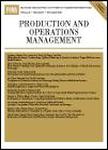-
作者:Athanassopoulos, AD; Iliakopoulos, A
摘要:The ability of telecommunication operators to focus successfully on the customer has proven to be one of the most competitive issues toward the end of the 20th century. The services management literature is short of theoretical and empirical studies on customer satisfaction measurement in the telecommunications industry. This, however, is contrary to the industry practice since almost all major telecommunications companies around the world gather information about customer satisfaction and oth...
-
作者:Goodale, JC; Verma, R; Pullman, ME
作者单位:University of Oregon; Utah System of Higher Education; University of Utah; Cornell University
摘要:Only a small set of employee scheduling articles have considered an objective of profit or contribution maximization, as opposed to the traditional objective of cost (including opportunity costs) minimization. In this article, we present one such formulation that is a market utility-based model for planning and scheduling in mass services (MUMS). MUMS is a holistic approach to market-based service capacity scheduling. The MUMS framework provides the structure for modeling the consequences of a...
-
作者:Mondschein, SV; Weintraub, GY
作者单位:Yale University; Stanford University
摘要:In this paper we review the literature on appointment policies, specifically in terms of the objective function commonly used and the assumptions made about the behavior of demand. First, we provide an economic framework to analyze the problem. Based on this framework we make a critical analysis of the objective functions used in the literature. We also question the validity of the assumption made throughout the literature that demand is exogenous and independent of customers' waiting times. W...
-
作者:Goldstein, SM
作者单位:Washington University (WUSTL)
摘要:A critical component of service strategy in high-contact environments is service encounter management. Effective service encounters are a result of the quality of employee development, including systems for work and job design, training and development, and attention to employee well being. Results of empirical analysis indicate that service strategies reflecting the dimensions of employee development drive employee outcomes such as productivity and satisfaction. Employee outcomes are signific...

